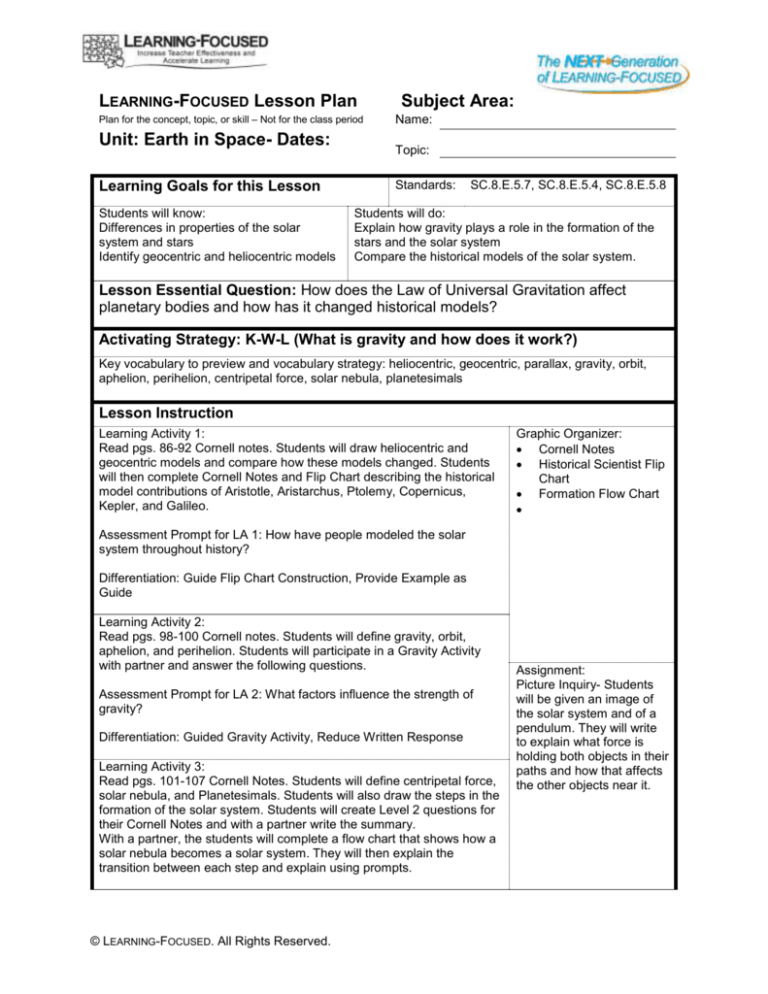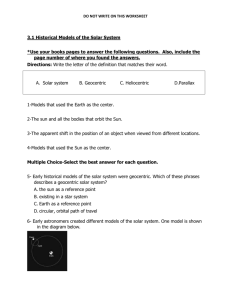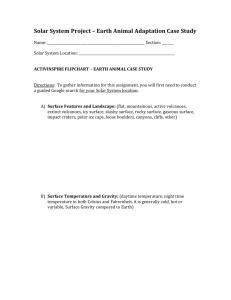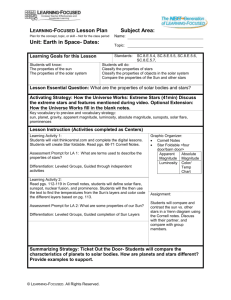
LEARNING-FOCUSED Lesson Plan
Plan for the concept, topic, or skill – Not for the class period
Unit: Earth in Space- Dates:
Learning Goals for this Lesson
Students will know:
Differences in properties of the solar
system and stars
Identify geocentric and heliocentric models
Subject Area:
Name:
Topic:
Standards:
SC.8.E.5.7, SC.8.E.5.4, SC.8.E.5.8
Students will do:
Explain how gravity plays a role in the formation of the
stars and the solar system
Compare the historical models of the solar system.
Lesson Essential Question: How does the Law of Universal Gravitation affect
planetary bodies and how has it changed historical models?
Activating Strategy: K-W-L (What is gravity and how does it work?)
Key vocabulary to preview and vocabulary strategy: heliocentric, geocentric, parallax, gravity, orbit,
aphelion, perihelion, centripetal force, solar nebula, planetesimals
Lesson Instruction
Learning Activity 1:
Read pgs. 86-92 Cornell notes. Students will draw heliocentric and
geocentric models and compare how these models changed. Students
will then complete Cornell Notes and Flip Chart describing the historical
model contributions of Aristotle, Aristarchus, Ptolemy, Copernicus,
Kepler, and Galileo.
Graphic Organizer:
Cornell Notes
Historical Scientist Flip
Chart
Formation Flow Chart
Assessment Prompt for LA 1: How have people modeled the solar
system throughout history?
Differentiation: Guide Flip Chart Construction, Provide Example as
Guide
Learning Activity 2:
Read pgs. 98-100 Cornell notes. Students will define gravity, orbit,
aphelion, and perihelion. Students will participate in a Gravity Activity
with partner and answer the following questions.
Assessment Prompt for LA 2: What factors influence the strength of
gravity?
Differentiation: Guided Gravity Activity, Reduce Written Response
Learning Activity 3:
Read pgs. 101-107 Cornell Notes. Students will define centripetal force,
solar nebula, and Planetesimals. Students will also draw the steps in the
formation of the solar system. Students will create Level 2 questions for
their Cornell Notes and with a partner write the summary.
With a partner, the students will complete a flow chart that shows how a
solar nebula becomes a solar system. They will then explain the
transition between each step and explain using prompts.
© LEARNING-FOCUSED. All Rights Reserved.
Assignment:
Picture Inquiry- Students
will be given an image of
the solar system and of a
pendulum. They will write
to explain what force is
holding both objects in their
paths and how that affects
the other objects near it.
Assessment Prompt for LA 3: How has gravity influenced the formation
of the solar system?
Differentiation: Cloze Flow Chart
Summarizing Strategy: Revisit K-W-L and complete. Review with partner.
Student
Modification/Accommodations
1. Seat student near teacher.
2. Stand near student when giving
directions/presenting.
3. Provide visual aids/graphic organizers.
4. Ensure oral directions are understood.
5. Allow extra time to complete tasks.
6. Simplify complex written directions.
7. Give test items orally.
8. Provide peer assistance/study groups.
© LEARNING-FOCUSED. All Rights Reserved.





